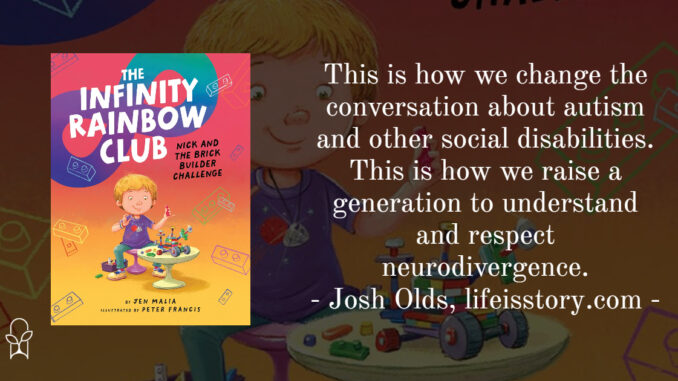
Also by this author: Violet and the Jurassic Land Exhibit, Connor and the Taekwondo Tournament
Series: The Infinity Rainbow Club #1
Published by Beaming Books on September 26, 2023
Genres: Children's
Buy on Amazon
Goodreads

When the Infinity Rainbow Club at school competes in a brick builder challenge, Nick can't wait to participate! Until he learns he must have a partner--the new girl. Nick wants to work alone. But to win, he'll have to figure out how to be part of a team.
A story about the universal struggle of learning to work together on a team, told from the perspective of an autistic child.
The Infinity Rainbow Club is a chapter book series featuring five neurodivergent children in a club at their elementary school. The club provides a safe space for stims and different communication styles to be accepted and celebrated.
The Infinity Rainbow Club is a series of middle-grade books focused on the adventures of a group of kids with various neurodivergences. The club within their school, the titular Infinity Rainbow Club is where they can hang out and be accepted and celebrated. There’s nothing exceptional or fantastical about the stories. It’s just about kids living their lives, navigating friendships and new challenges, learning and growing. In this way, The Infinity Rainbow Club accomplishes two things. First, for readers with some sort of neurodivergence, they can see characters who look, think, and feel like them. Second, it demystifies neurodivergence by presenting it as a social difference rather than an innate disability.
Nick and the Brick Builder Challenge follows Nick Newton, a young, Autistic boy who is very good at building with Legos and would prefer it if nobody helped him. His problem is that there will be somebody helping him. And not just somebody but somebody new. Nick will have to work through a new relationship, learn to share his vision, and find a way for his new friend to be part of what he’s doing.
The most incredible thing about this book is how authentically it captures autism. The language is clear and straightforward. Author Jen Malia explains neurodivergences by example using positive language that is kid-friendly and avoids a disability model of thinking. In the opening scene, we see a group of kids in an “action room.” Nick is who we are introduced to first and the paragraph goes like this:
“Nick Newton climbed up the rope ladder and launched himself through the royal-blue tube slide. It was his favorite color. Not sky blue. Not turquoise. But royal blue….Plunging into a pit of foam cubes in the sensory gym was just what he needed after school…Nick dug his hand free from the cubes and slipped it under the neck of his Mars t-shirt. Rubbing the smooth surface of his pendant necklace comforted him. He didn’t go anywhere without his moon meteorite dust.”
In that opening, the word “autism” or “autistic” is never used. Instead we see some traits—the sensory comfort of a familiar object or a having very specific categories for favorite things. The next person who is introduced is Violet, who “check(s) everything seven times because seven was her lucky number.” This offers an example of OCD without trivializing it or stigmatizing it. Next is Jasmine, who speaks only with an AAC tablet. And so on. While neurodivergences are unfortunately often painted in a negative light, author Jen Malia turns that light off and lets the true inner light shine bright. The story itself is fun, simple, and straightforward. Nick has to learn to work with a partner despite wanting to work by himself. Through the story, readers gain insight on how various characters talk, think, and act. It just felt so authentic and real.
The success of The Infinity Rainbow Club comes from Jen Malia, the mother of three neurodivergent children who herself was diagnosed with ASD as an adult. Her personal experience as a mom and as someone who is Autistic has helped her create a story that helps young readers understand neurodivergence in a positive way. Even the book design is meant to help with this. Malia writes with straightforwardness and clarity. No metaphors or allusions. The text itself is a sans-serif font, which studies have shows help individuals with dyslexia read more accurately and quickly. Everything about this book comes from a neurodiversity-affirming aspect and is intentionally crafted to be affirming and accessible.
This book, this series—it’s such a blessing. There are kids who will read this is feel more empowered and less lonely. They will feel loved. They will feel seen. There are kids who will read this and have more understanding about why their friend does some things that seem unusual to them. This is how we change the conversation about autism and other social disabilities. This is how we begin to celebrate and accommodate diversity. This is how we ensure that we raise a generation that respects and understands these differences. I’m so thankful for books like this.
